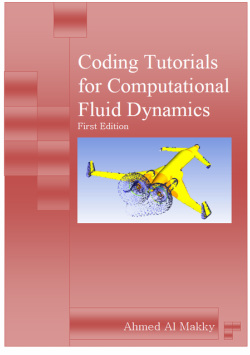Book on Coding Tutorials for Computational Fluid Dynamics
|
The book provides some of the many codes that where written during my PhD period, also provides some guidance to how to work in the field of computational fluid mechanics and where to start and from where to get answers to your questions. The book shows the researcher how to use for loops, how to visualize and generated data, how to program equations, how to generate meshes, how to deal with Cartesian, cylindrical an spherical coordinates to model a problem. The provided skills in this book provide the researcher with the required tools to write codes of his own and even develop new turbulence models.
|
Online Material on Numerical Analysis
The following three links provide theoretical material on numerical analysis relating to the field of computational fluid dynamics:
1-Cambridge University excellent web site.
2-University of Texas at Austin, Computational Physics.
3-STONY BROOK UNIVERSITY APPLIED MATHEMATICS AND STATISTICS.
1-Cambridge University excellent web site.
2-University of Texas at Austin, Computational Physics.
3-STONY BROOK UNIVERSITY APPLIED MATHEMATICS AND STATISTICS.
General Info
The spectral element method is a formulation of finite element method with a high degree piceswise polynomial basis.
The following link provides an excellent source of description, legendre and chebyshev expansions:
http://www.lorene.obspm.fr/palma.pdf
Types of spaces:
The use of diffrent spaces comes to solve PDEs problems in easier methods.
Metric Space
Uniform Space
Hardy Space
Vector Space
Inner Product Space
Cauchy Space
Kolmogorov Space
Polish Space
Hilbert Space
Banach Space
Sobolev Space
The following link provides an excellent source of description, legendre and chebyshev expansions:
http://www.lorene.obspm.fr/palma.pdf
Types of spaces:
The use of diffrent spaces comes to solve PDEs problems in easier methods.
Metric Space
Uniform Space
Hardy Space
Vector Space
Inner Product Space
Cauchy Space
Kolmogorov Space
Polish Space
Hilbert Space
Banach Space
Sobolev Space
Collocation Method
A collocation method is used for the simulation of ordinary differential equations, partial differential equations and integral equations.
Solving ODEs using MATLAB
The following link provides some excellent examples on solving ODEs using MATLAB written by P.Howard Fall 2007
http://www.cs.rice.edu/~nakhleh/COMP572/Papers/matode.pdf
The following link has a problem that solves a bouncing ball case where the initial conditionas are changed after each terminal event, the code is applied for an ode
http://dora.eeap.cwru.edu/msb/HS/ballode.m
The same example is also provided on the MathsWorks website:
http://www.mathworks.co.uk/matlabcentral/fileexchange/15643-odes-and-daes-of-index-up-to-3-solvers/content/example/ballode.m
http://www.cs.rice.edu/~nakhleh/COMP572/Papers/matode.pdf
The following link has a problem that solves a bouncing ball case where the initial conditionas are changed after each terminal event, the code is applied for an ode
http://dora.eeap.cwru.edu/msb/HS/ballode.m
The same example is also provided on the MathsWorks website:
http://www.mathworks.co.uk/matlabcentral/fileexchange/15643-odes-and-daes-of-index-up-to-3-solvers/content/example/ballode.m
Working with DFT
The following Link provides solved examples in MATLAB for dealing with DFT
http://www.phys.nsu.ru/cherk/fft.pdf
http://www.phys.nsu.ru/cherk/fft.pdf
Unless otherwise noted, all content on this site is @Copyright by Ahmed Al Makky 2012-2013 - http://cfd2012.com
